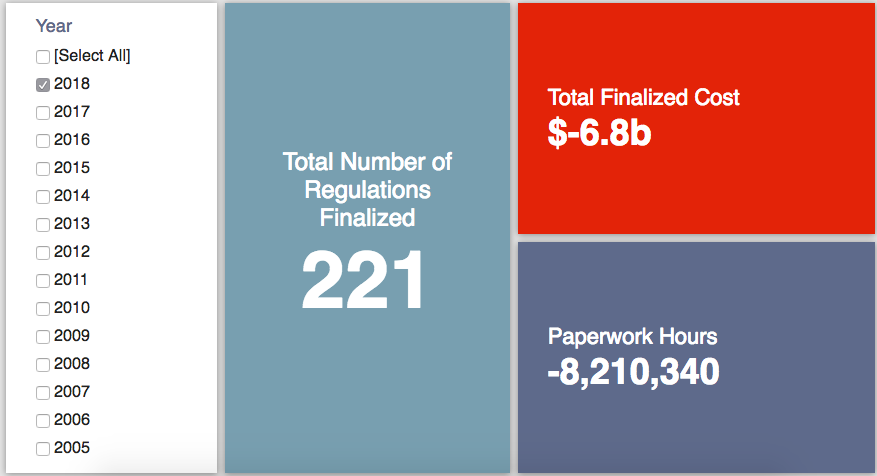Week in Regulation
September 24, 2018
Deregulation Picks Up Pace: September 17 – 21
As the end of the regulatory budget year approaches, agencies appear to be ramping up their deregulatory activity. Of the nine final rules published with estimated costs last week, six were deregulatory. Meanwhile, a significant deregulatory proposal also arrived. Between both proposed and final rules last week, agencies published roughly $1.9 billion in net cost savings, and reduced paperwork by 4.1 million hours. The per capita regulatory burden for 2018 is negative $20.76.
REGULATORY TOPLINES
- New Proposed Rules: 49
- New Final Rules: 65
- 2018 Total Pages of Regulation: 47,934
- 2018 Final Rules: -$6.8 Billion
- 2018 Proposed Rules: -$544.9 Billion
Last week’s most noteworthy action was a proposed rule from the Department of Health and Human Services (HHS). Its wide-ranging “Medicare and Medicaid Programs: Regulatory Provisions To Promote Program Efficiency, Transparency, and Burden Reduction” proposal touches on several sections of the Medicare regulatory code, and aims to reform regulations that it deems “unnecessary, obsolete, or excessively burdensome on health care providers and suppliers.” HHS estimates the total savings of the proposal at $1.06 billion.
TRACKING REGULATORY MODERNIZATION
The regulatory budget year ends on September 30. As agencies try to reach and exceed their annualized savings targets, there was a noticeable uptick in final rules that are considered deregulatory actions under Executive Order 13,771. Six such rules were published last week, whereas just seven actions had been published since July 30.
The largest deregulatory action last week was the Department of Energy’s (DOE) “Energy Conservation Program: Test Procedures for Integrated Light-Emitting Diode (LED) Lamps” rule. Manufacturers were required to undertake two separate lifetime tests for their LED lamps – one at ambient temperature to meet DOE’s regulations and one at elevated temperatures to meet ENERGY STAR requirements. DOE’s new rule would allow manufacturers to run one test at elevated temperatures to satisfy both. DOE estimates annualized savings of $22.96 million under the new rule.
The Department of Transportation (DOT) issued three of the remaining five deregulatory actions last week. Its most notable rule would allow diabetic individuals with a stable insulin regimen to operate a commercial motor vehicle in interstate commerce if they receive the appropriate certificate from a certified medical examiner. Previously, such individuals had to individually petition DOT for an exemption. DOT estimates annualized savings of the new rule at $6.35 million.
According to AAF analysis, since the start of FY 2018 (beginning Oct. 1, 2017), executive agencies have promulgated 60 deregulatory actions with quantified estimates against 12 regulatory measures, under the rubric created by EO 13,771 and the administration’s subsequent guidance document on the matter. These rules combine for net annual savings of roughly $1.6 billion. This means that agencies have thus far surpassed the administration’s cumulative goal for FY 2018 of $687 million in net annual savings by nearly $1 billion. According to earlier AAF projections based on the administration’s latest Unified Agenda, agencies were on track to roughly double that goal. If this current trend holds, they may well exceed that expectation too.
Click here to view AAF’s examination of the administration’s progress under the “one-in, two-out” executive order through the end of Fiscal Year 2017.
STATE OF MAJOR OBAMA-ERA INITIATIVES
Based on total lifetime costs of the regulations, the ACA has imposed costs of $52.9 billion in final state and private-sector burdens and 176.9 million annual paperwork hours.
Since passage, the Dodd-Frank financial reform legislation has produced more than 82.9 million final paperwork burden hours and imposed $38.9 billion in direct compliance costs.
TOTAL BURDENS
Since January 1, the federal government has published $551.7 billion in net cost savings (with $6.8 billion in net savings from final rules) and paperwork burdens amounting to roughly 5.1 million hours (including 8.2 million hours of paperwork reduced under final rules). Click here for the latest Reg Rodeo findings.











